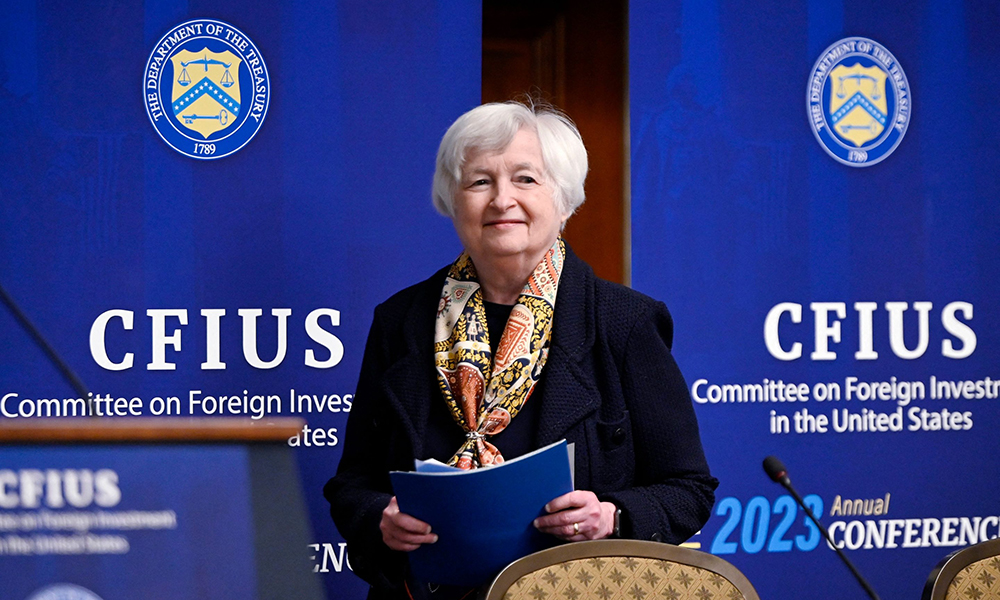
美国国债的规模已经接近33万亿美元了,但美国财政部部长珍妮特·耶伦目前似乎并不担心这个问题。9月18日,她提到了一个重要的统计数据,以此试图让人们相信美国政府持续增长的债务负担仍然是可控的。
耶伦在9月18日接受美国消费者新闻与商业频道(CNBC)采访时表示:“在判断财政工作形势时,我最经常关注的一个统计指标就是净利息占GDP的比重。”此处的“净利息”是指美国联邦政府的债务利息净支出占美国GDP的比重。“即使我们看到利率有所上升,但这个指标仍然保持在一个非常合理的水平。”
在耶伦看来,2022年,美国联邦政府的利息支出约占GDP的1.86%,此数据出自美联储(Federal Reserve)。这与1960年以来略低于2%的历史平均水平是基本一致的。

耶伦称,目前她仍然“并不真正担心”近期的联邦支出项目会导致财政赤字——例如用于补贴半导体生产与研发的《芯片与科学法案》(CHIPS and Science Act),用于修桥修路的《基础设施投资与就业法案》(Infrastructure Investment and Jobs Act),等等。她认为,联邦政府只需要“确保我们具有可持续发展的能力”。
不过,美国国会预算办公室(Congressional Budget Office)在今年6月的一份报告里警告道,如果利率与国债持续上涨下去,到2053年,美国联邦政府的净利息支出占GDP的比重就将达到6.7%。
“如此之高且仍然在不断上升的政府债务将减缓经济增长的速度,抬高美债的外国债权人的利息收入,并对美国的财政和经济前景造成重大风险,这也可能导致立法者在政策选择上更加束手束脚。”该报告的作者解释道。
有些批评人士对美债规模持续走高的潜在风险给出了更严厉的警告。比如对冲基金Universa Investments的创始人马克·施皮茨纳格尔在今年8月告诉《财富》杂志,美国正在经历“人类历史上最大的信贷泡沫”。
“我们从未见过金融体系中出现过如此之高的总体债务和杠杆水平。这是个实验,但我们都知道信贷泡沫总有被刺破的一天。我们不知道这一天会在何时到来,但它总有到来的一天。”
施皮茨纳格尔指出,今年第二季度,美国民间债务总体规模达到了创纪录的17万亿美元,其中,非住房债务达到了4.7万亿美元的历史最高水平。据美联储的数据,算起来,美国的总债务水平已经达到了GDP的120%。
耶伦在9月18日接受采访时也承认,将来联邦政府“必须确保”财政赤字可控,否则国债就将成为美国经济的一个大问题。
“当然,大幅削减赤字也是一个具有可能性的目标。”她补充道:“拜登总统已经提出了一系列逐步降低财政赤字,同时对经济进行投资的措施,这些就是我们将来需要做的事情。”
谈汽车工人罢工
在采访中,耶伦还被问到了美国汽车工人联合会(United Auto Workers)的罢工问题,这场罢工同时影响了底特律的三大汽车巨头——福特(Ford)、通用汽车(GM)和Stellantis,并且引起了经济学家和投资者的关注。耶伦表示,她希望美国汽车工人联合会和三巨头尽快达成一份“双赢协议”,但她拒绝在现阶段讨论此次罢工对经济的潜在影响。
“我认为现在预言它对经济的影响还为时过早。这在很大程度上要取决于罢工持续多久,以及有多少人会受到它的影响。”她说。
受新冠疫情影响,很多企业之前都遭遇了用工荒,因此美国就业市场也出现了连续几年的强劲态势。但在9月18日,耶伦承认,目前美国就业市场上的招聘热度正在降温。不过总体来看,虽然罢工和美债上涨都给经济造成了潜在威胁,但耶伦认为,美国经济当前的总体走势仍然强劲。
“我们的劳动力市场仍然是良好的、健康的,消费支出和工业生产也依然保持强劲。我没有看到任何迹象表明经济有下行风险。对于经济来说,劳动力市场保持强劲,通胀水平下降,经济持续走强,这是最理想的情况了,而这也是我们当前正在看到的情况。”(财富中文网)
译者:朴成奎
美国国债的规模已经接近33万亿美元了,但美国财政部部长珍妮特·耶伦目前似乎并不担心这个问题。9月18日,她提到了一个重要的统计数据,以此试图让人们相信美国政府持续增长的债务负担仍然是可控的。
耶伦在9月18日接受美国消费者新闻与商业频道(CNBC)采访时表示:“在判断财政工作形势时,我最经常关注的一个统计指标就是净利息占GDP的比重。”此处的“净利息”是指美国联邦政府的债务利息净支出占美国GDP的比重。“即使我们看到利率有所上升,但这个指标仍然保持在一个非常合理的水平。”
在耶伦看来,2022年,美国联邦政府的利息支出约占GDP的1.86%,此数据出自美联储(Federal Reserve)。这与1960年以来略低于2%的历史平均水平是基本一致的。
耶伦称,目前她仍然“并不真正担心”近期的联邦支出项目会导致财政赤字——例如用于补贴半导体生产与研发的《芯片与科学法案》(CHIPS and Science Act),用于修桥修路的《基础设施投资与就业法案》(Infrastructure Investment and Jobs Act),等等。她认为,联邦政府只需要“确保我们具有可持续发展的能力”。
不过,美国国会预算办公室(Congressional Budget Office)在今年6月的一份报告里警告道,如果利率与国债持续上涨下去,到2053年,美国联邦政府的净利息支出占GDP的比重就将达到6.7%。
“如此之高且仍然在不断上升的政府债务将减缓经济增长的速度,抬高美债的外国债权人的利息收入,并对美国的财政和经济前景造成重大风险,这也可能导致立法者在政策选择上更加束手束脚。”该报告的作者解释道。
有些批评人士对美债规模持续走高的潜在风险给出了更严厉的警告。比如对冲基金Universa Investments的创始人马克·施皮茨纳格尔在今年8月告诉《财富》杂志,美国正在经历“人类历史上最大的信贷泡沫”。
“我们从未见过金融体系中出现过如此之高的总体债务和杠杆水平。这是个实验,但我们都知道信贷泡沫总有被刺破的一天。我们不知道这一天会在何时到来,但它总有到来的一天。”
施皮茨纳格尔指出,今年第二季度,美国民间债务总体规模达到了创纪录的17万亿美元,其中,非住房债务达到了4.7万亿美元的历史最高水平。据美联储的数据,算起来,美国的总债务水平已经达到了GDP的120%。
耶伦在9月18日接受采访时也承认,将来联邦政府“必须确保”财政赤字可控,否则国债就将成为美国经济的一个大问题。
“当然,大幅削减赤字也是一个具有可能性的目标。”她补充道:“拜登总统已经提出了一系列逐步降低财政赤字,同时对经济进行投资的措施,这些就是我们将来需要做的事情。”
谈汽车工人罢工
在采访中,耶伦还被问到了美国汽车工人联合会(United Auto Workers)的罢工问题,这场罢工同时影响了底特律的三大汽车巨头——福特(Ford)、通用汽车(GM)和Stellantis,并且引起了经济学家和投资者的关注。耶伦表示,她希望美国汽车工人联合会和三巨头尽快达成一份“双赢协议”,但她拒绝在现阶段讨论此次罢工对经济的潜在影响。
“我认为现在预言它对经济的影响还为时过早。这在很大程度上要取决于罢工持续多久,以及有多少人会受到它的影响。”她说。
受新冠疫情影响,很多企业之前都遭遇了用工荒,因此美国就业市场也出现了连续几年的强劲态势。但在9月18日,耶伦承认,目前美国就业市场上的招聘热度正在降温。不过总体来看,虽然罢工和美债上涨都给经济造成了潜在威胁,但耶伦认为,美国经济当前的总体走势仍然强劲。
“我们的劳动力市场仍然是良好的、健康的,消费支出和工业生产也依然保持强劲。我没有看到任何迹象表明经济有下行风险。对于经济来说,劳动力市场保持强劲,通胀水平下降,经济持续走强,这是最理想的情况了,而这也是我们当前正在看到的情况。”(财富中文网)
译者:朴成奎
The U.S. national debt is nearing $33 trillion, but Janet Yellen isn’t worried just yet. The Treasury Secretary pointed to a key statistic on September 18 that, she believes, illustrates that the federal government’s growing debt burden remains under control.
“The statistic or metric that I look at most often to judge our fiscal course is net interest as a share of GDP,” she told CNBC on September 18, referring to the net payments the federal government makes on its debt relative to U.S. gross domestic product. “And even with the rise we have seen in interest rates that remains at a very reasonable level.”
To Yellen’s point, the federal government’s interest payments represented 1.86% of GDP in 2022, according to Federal Reserve data. That’s in line with the historical average since 1960 of just under 2%.
Yellen said she is still “not really concerned about the impact” that recent federal spending programs—including the CHIPS and Science Act that subsidizes semiconductor production and research and the Infrastructure Investment and Jobs Act that authorizes spending on roads, bridges, and other infrastructure projects—will have on the national deficit, arguing the federal government just needs “to make sure that we stay on a sustainable course.”
Still, the Congressional Budget Office warned in a June report that higher interest rates and the mounting national debt could lead the federal government’s net interest payments to spike to 6.7% of GDP by 2053.
“Such high and rising debt would slow economic growth, push up interest payments to foreign holders of U.S. debt, and pose significant risks to the fiscal and economic outlook; it could also cause lawmakers to feel more constrained in their policy choices,” the report’s authors explained.
Some critics have gone a step further in their warnings about the potential impact of an increasingly indebted U.S. government. Mark Spitznagel, founder of the hedge fund Universa Investments, told Fortune in August that we’re living through the “greatest credit bubble in human history.”
“We’ve never seen anything like this level of total debt and leverage in the system. It’s an experiment,” he said. “But we know that credit bubbles have to pop. We don’t know when, but we know they have to.”
Spitznagel pointed out that total public household debt hit a record $17 trillion in the second quarter, with non-housing debt hitting an all-time high $4.7 trillion, and the U.S. debt to GDP ratio was 120%, according to Federal Reserve data.
Yellen did admit on September 18 that, moving forward, the federal government will need to “make sure” to keep deficits under control, otherwise the national debt could become an issue.
“Certainly greater deficit reduction is possible,” she added. “The President has proposed a series of measures that would reduce our deficits over time, while investing in the economy and this is something we need to do going forward.”
The United Auto Workers’ strike
The Treasury Secretary was also asked about the United Auto Workers’ (UAW) strike that has affected Detroit’s Big Three—Ford, GM, and Stellantis—and begun to concern economists and investors. She said that she hoped the UAW and the Big Three would come to a “win-win agreement” as soon as possible and refused to discuss any potential impact to the economy at this stage.
“I think it’s premature to be making forecasts about what it means for the economy. It would depend very much on how long the strike lasts and exactly who is affected by it,” she said.
After years of almost unprecedented strength in the labor market during the pandemic when businesses struggled to find talent, Yellen admitted that hiring is cooling on September 18. But overall, despite the threat of workers’ strikes and a rising national debt, she said that she believes the economy remains strong.
“Look, we still have a good, healthy labor market. Consumer spending remains quite robust. We’ve seen strong industrial production. I don’t see any signs that the economy is at risk of a downturn,” she said. “This is the best of all worlds to see continued strength in the economy, a good strong labor market, and inflation moving down, and this is what we’re seeing.”






